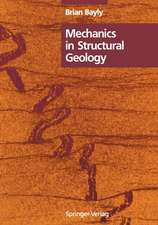The Geology of Fluvial Deposits: Sedimentary Facies, Basin Analysis, and Petroleum Geology
Autor Andrew D. Miallen Limba Engleză Hardback – 6 iun 2006
| Toate formatele și edițiile | Preț | Express |
|---|---|---|
| Paperback (1) | 976.24 lei 6-8 săpt. | |
| Springer Berlin, Heidelberg – 17 dec 2010 | 976.24 lei 6-8 săpt. | |
| Hardback (1) | 862.62 lei 38-44 zile | |
| Springer Berlin, Heidelberg – 6 iun 2006 | 862.62 lei 38-44 zile |
Preț: 862.62 lei
Preț vechi: 1135.02 lei
-24% Nou
Puncte Express: 1294
Preț estimativ în valută:
165.08€ • 179.25$ • 138.67£
165.08€ • 179.25$ • 138.67£
Carte tipărită la comandă
Livrare economică 18-24 aprilie
Preluare comenzi: 021 569.72.76
Specificații
ISBN-13: 9783540591863
ISBN-10: 3540591869
Pagini: 600
Ilustrații: XVI, 582 p.
Dimensiuni: 210 x 279 x 38 mm
Greutate: 1.74 kg
Ediția:1st ed. 1996. Corr. 3rd printing 2006
Editura: Springer Berlin, Heidelberg
Colecția Springer
Locul publicării:Berlin, Heidelberg, Germany
ISBN-10: 3540591869
Pagini: 600
Ilustrații: XVI, 582 p.
Dimensiuni: 210 x 279 x 38 mm
Greutate: 1.74 kg
Ediția:1st ed. 1996. Corr. 3rd printing 2006
Editura: Springer Berlin, Heidelberg
Colecția Springer
Locul publicării:Berlin, Heidelberg, Germany
Public țintă
ResearchDescriere
Fluvial deposits represent the preserved record of one of the major nonmarine environ ments. They accumulate in large and small intermontane valleys, in the broad valleys of trunk rivers, in the wedges of alluvial fans flanking areas of uplift, in the outwash plains fronting melting glaciers, and in coastal plains. The nature of alluvial assemblages - their lithofacies composition, vertical stratigraphic record, and architecture - reflect an inter play of many processes, from the wandering of individual channels across a floodplain, to the long-term effects of uplift and subsidence. Fluvial deposits are a sensitive indicator of tectonic processes, and also carry subtle signatures of the climate at the time of deposition. They are the hosts for many petroleum and mineral deposits. This book is about all these subjects. The first part of the book, following a historical introduction, constructs the strati graphic framework of fluvial deposits, step by step, starting with lithofacies, combining these into architectural elements and other facies associations, and then showing how these, in turn, combine to represent distinctive fluvial styles. Next, the discussion turns to problems of correlation and the building of large-scale stratigraphic frameworks. These basin-scale constructions form the basis for a discussion of causes and processes, including autogenic processes of channel shifting and cyclicity, and the larger questions of allogenic (tectonic, eustatic, and climatic) sedimentary controls and the development of our ideas about nonmarine sequence stratigraphy.
Cuprins
1 Introduction.- 2 Historical Background.- 3 Concepts of Scale.- 4 Methods of Architectural-Element Analysis.- 5 Lithofacies.- 6 Architectural Elements Formed Within Channels.- 7 Architectural Elements of the Overbank Environment.- 8 Fluvial Styles and Facies Models.- 9 The Stratigraphic Architecture of Fluvial Depositional Systems.- 10 Fluvial Depositional Systems and Autogenic Sedimentary Controls.- 11 Tectonic Control of Fluvial Sedimentation.- 12 What Does Fluvial Lithofacies Reveal About Climate?.- 13 Sequence Stratigraphy.- 14 Stratigraphic and Tectonic Controls on the Distribution and Architecture of Fluvial Oil and Gas Reservoirs.- 15 Case Studies of Oil and Gas Fields in Fluvial Reservoirs.- 16 Future Research Trends.- References.- Author Index.
Recenzii
"...it acts as a splendid source of research material and problems, because not much has missed Andrew Mialls eagle eye." Jnl of Sedimentary Research
Textul de pe ultima copertă
The Geology of Fluvial Deposits represents the first published synthesis of research on the sedimentary geology of fluvial deposits. It sets out in detail the methods for the field and subsurface study of these sediments, and provides geologists with detailed descriptions of the building blocks of fluvial stratigraphic units, from lithofacies through architectural elements and depositional systems to large-scale stratigraphic sequences and basin-fill complexes. This book also examines at length autogenic sedimentary controls and discusses the tectonic and climatic controls of fluvial sedimentation and the effects of base level change on sequence architecture. The book contains a new classification of oil and gas fields in fluvial reservoirs, with descriptions of selected case examples. Profusely illustrated and with an extensive reference to the recent literature this textbook will be welcomed by the student and professional geologist alike.











